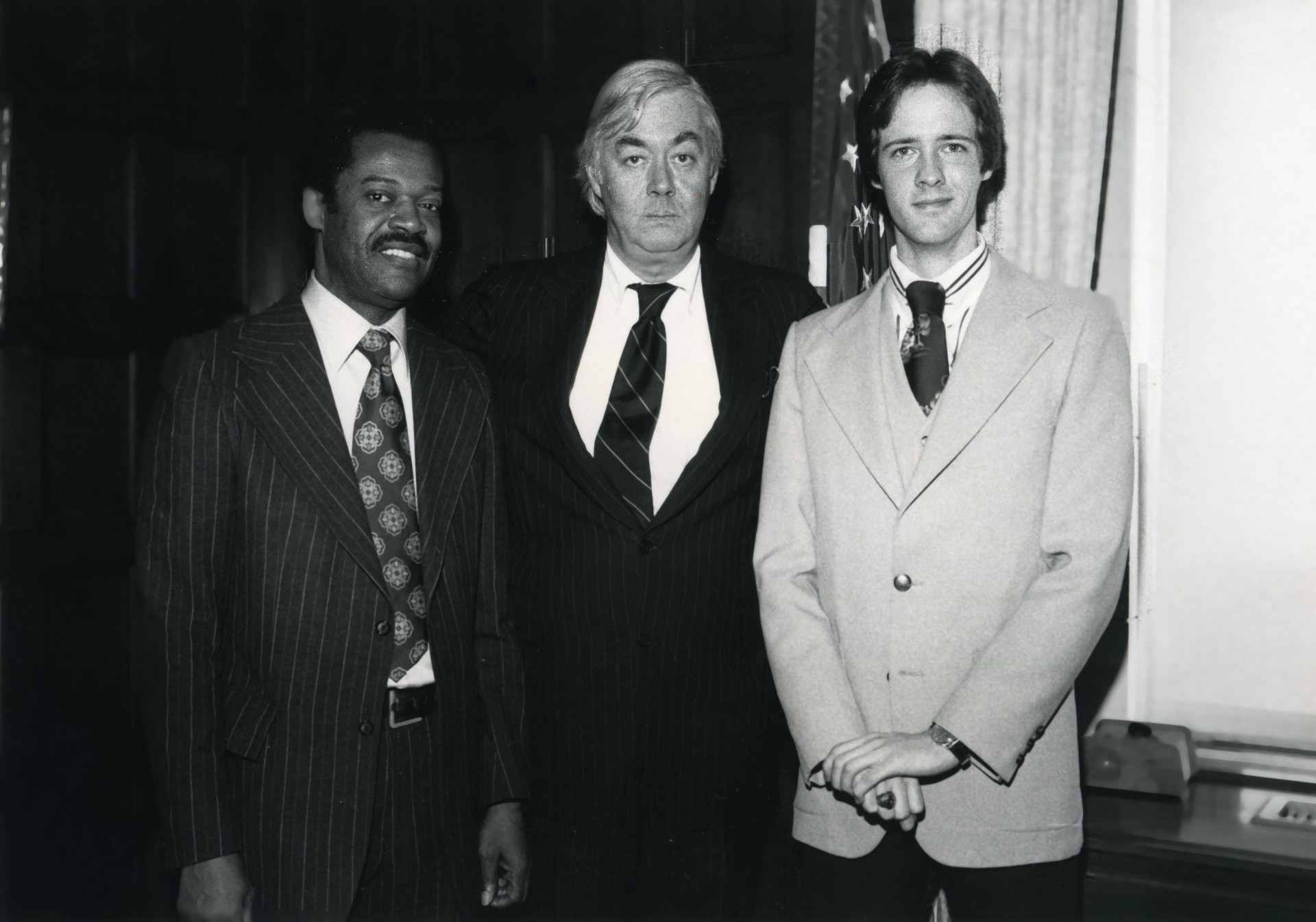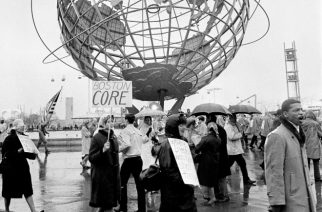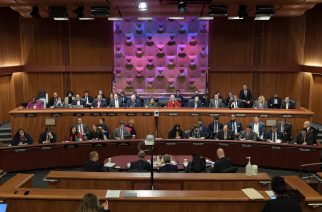
From left, Assemblyman Edward Griffith, U.S. Senator Daniel Patrick Moynihan, and John Halloran.
The Honorable Edward Griffith of Brooklyn, N.Y. passed on October 26, 2023, at 92 years of age, and it is important to recall and celebrate his life and legacy, as well as his enduring contributions to the law of New York.
From 1973 through 2000, Mr. Griffith represented the 40th Assembly District, which covered a portion of East New York, Brownsville, and East Flatbush, in Brooklyn, Kings County. He received his B.A. in education from the Canal Zone College in Panama, and a B.A. in Political Science from Queens College. Before his election to the Assembly, Mr. Griffith had a background in banking, served with the United Nations International School Association, and was the first president of Community School Board, District 19. He also served in the United States Air Force, as missile technician, from 1955 to 1961.
Mr. Griffith made vast contributions to New York law. He was the only nonlawyer on the Assembly Judiciary Committee for many years. This was a testament to his good judgment and deep understanding of the needs of the community. One of the Judiciary Committee’s intellectual leaders, Ralph Goldstein of Queens, warmly praised “Eddie” as “the most decent man in the Legislature.”
Mr. Goldstein’s view was shared by his colleagues who, through Assembly leadership, named Mr. Griffith as the Chair of the Assembly Ethics & Guidance Committee. The Committee was constituted by an equal number of Republicans and Democrats. The Committee included the best and brightest lawyers in the Assembly such as Hon. Arthur J. Cooperman and Hon. J. Kemp Hannon. As Chair of the Committee, Mr. Griffith authored the Ethics Manual for Members and Employees of the New York State Assembly (1981). He published a paper entitled Incompatibility of Office: The New York Perspective (1982). He introduced ethics legislation and prepared confidential advisory opinions. Much of this work was completed with the assistance of his distinguished counsel, Edward Desmond, Esq. of Buffalo, N.Y. The Committee was highly professional, nonpartisan, and it conducted its business by consensus.
Mr. Griffith was steadfastly committed to the people of his 40th Assembly District and he enjoyed a close working relationship with all community leaders.
In 1981, one of those leaders, Bishop Francis J. Mugavero of the Diocese of Brooklyn, reached out to Mr. Griffith to explain a crisis facing children attending nonpublic schools in New York state. Near the close of the legislative session, the State Education Department announced an alarming decision to terminate what was called “suitable transportation” for children with “handicapping conditions” to and from “nonpublic schools.” Working late into the night, Mr. Griffith spearheaded emergency legislation to preserve the transportation services. Governor Hugh L. Carey issued a message of necessity to enable an immediate vote on the bill. The governor signed the bill into law as Chapter 996 of the Laws of 1981, which continues to protect our most vulnerable citizenry today.
Mr. Griffith was also a proponent of court reform. For example, the federal and state courts owe a continuing debt of gratitude to Mr. Griffith for his leadership in amending the State Constitution to give the New York Court of Appeals the power and discretion to answer certified questions of New York law from certain other courts, such as the U.S. Court of Appeals for the Second Circuit. The procedure is called interjurisdictional certification and it serves important jurisprudential interests.
Mr. Griffith’s leadership was commended by Chief Judge Judith S. Kaye and Kenneth I. Weissman (Interactive Judicial Federalism: Certified Questions in New York, 69 Fordham L. Rev. 373, 387-393 (2000)) and Chief Judge Sol Wachtler (Federalism is Alive and Well and Living in New York, 75 Alb. L. Rev. 659, 662 (2011)). “Thirty years have passed since the certification procedure was adopted, and its results have met with enthusiastic approval.” Advisory Group to the New York State and Federal Judicial Council, at Forward (March 2016).
Mr. Griffith possessed genuine empathy and kindness. He was moved by the tragic death of boxer Willie Classen of the Bronx, who died from brain injuries after a brutal contest at Madison Square Garden’s Felt Forum. For most of the 20th century, boxing in New York had been regulated by the so-called Walker Law, named after its sponsor, then-Senator James J. (“Jimmy”) Walker. Mr. Griffith believed that the archaic law needed reform and that the risk of tragedies in the ring could be mitigated with common-sense regulation, such as requiring ambulances at matches and paramedical training for personnel. To that end, Mr. Griffith introduced boxing reform legislation to wide acclaim (George Vecsey, Safety in the Ring, New York Times, Page 21, Feb. 14, 1981). Governor Carey followed Mr. Griffith’s lead and offered his own bill — sponsored in the Senate by legendary Senator Warren Anderson of Binghamton and by Mr. Griffith in the Assembly — to overhaul the Walker Law and enhance safety for boxers consistent with the policy aims advocated by Mr. Griffith (Boxing Safety Bill Introduced, New York Times, Section B, Page 16 (May 5, 1981)). Governor Carey signed the bill into law in July 1981 (Carey Signs Boxing Bill, New York Times, Section 1, Page 18 (July 18, 1981)).
Mr. Griffith was the quintessential role model. By example, he taught the fundamental tenets of professionalism — attention to detail, punctuality, clear writing, respect for everyone, an orderly desk, humility, and, most of all, integrity. He was inclusive at every opportunity. He went out of his way to make sure I was included in his meetings with national leaders such as Senator Daniel Patrick Moynihan. He made sure I met the former Governor and Vice President Nelson A. Rockefeller when the Empire State Mall was dedicated in his honor in October 1978.
Today, Mr. Griffith’s singular decency still resonates and should be emulated by those who are and were privileged to be participants in the legislative process.
Mr. Halloran is a member of the New York and District of Columbia bars, with law offices in White Plains, N.Y. On a part-time basis, he worked for Mr. Griffith from 1978 to 1983 in Albany and New York City. Upon graduation from Albany Law School, Mr. Halloran served as law clerk to Senior Associate Judge Matthew J. Jasen of the New York Court of Appeals. He later represented the United States as a trial attorney in the U.S. Justice Department in Washington, D.C.









